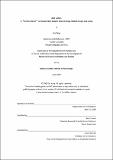BIM Game : a "serious game" to educate non-experts about energy related design and living
Author(s)
Yang, Lin, S.M. Massachusetts Institute of Technology
DownloadFull printable version (7.763Mb)
Alternative title
Building Information Modeling Game : a "serious game" to educate non-experts about energy related design and living
Serious game to educate non-experts about energy related design and living
Other Contributors
Massachusetts Institute of Technology. Dept. of Architecture.
Advisor
Kent Larson.
Terms of use
Metadata
Show full item recordAbstract
Climate Change is one defining issue of our time. With the increasingly sophisticated uses of energy, we have to face the problem as energy shortage and global warming. Since almost one-fourth of US energy is consumed by homes, creating high-performance low-energy houses and educating people about energy-related decision making, is perhaps the first and most cost-effective way of addressing energy issue. Towards this end, I propose a learning tool to educate non-experts about energy-related design and decision-making of their own homes. This tool, BIM Game, is based on BIM (Building Information Modeling) and E-learning game. By integrating BIM and Serious Game together, the new responsive model can change design education from the professionals to all people who care about energy issue and living environment. Through learning by playing, it is able to create a deep-learning environment and also add emotion to the problem-solving process. It also explores innovative shifts in building industry for consumer participative design and file-to-factory fabrication strategies, change the role of the consumer from the last benefit end-user to the first decision maker. So finally it will take advantage of the inexpensive computation, to raise the public awareness of participative design, energy efficiency, healthy living, and sustainability.
Description
Thesis (S.M.)--Massachusetts Institute of Technology, Dept. of Architecture, 2009. This electronic version was submitted by the student author. The certified thesis is available in the Institute Archives and Special Collections. Includes bibliographical references (p. 99-100).
Date issued
2009Department
Massachusetts Institute of Technology. Department of ArchitecturePublisher
Massachusetts Institute of Technology
Keywords
Architecture.